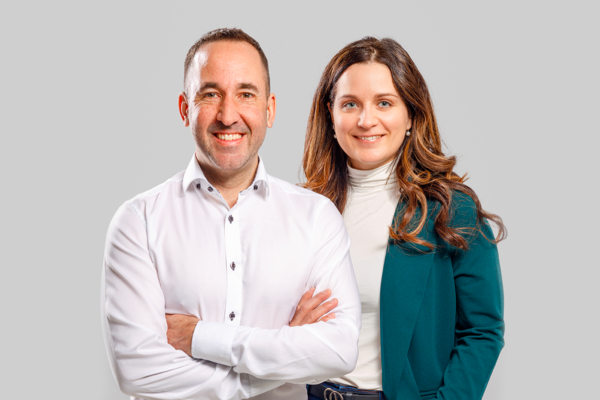Global warming, ocean acidification, biodiversity loss… Many of us are worried in the face of all this turmoil. For Christian Poudrier, President and CEO of Enerprox, the only way to stay optimistic about the future is to act.
“The absence of anxiety [in the face of climate change] is much more of a worry than anxiety in and of itself,” Christian says. (…) “Fear resulting from awareness is the superpower of anticipation. It results from an ability to project ourselves in time. We work every day with a sense of urgency, hoping to help create an inspiring future for our children. But engaging in impact entrepreneurship remains an act of faith.”
In 2015, Christian and his spouse, Audrey Corriveau, became owners of two La petite école Vision schools.
Audrey and Christian quickly realized that La petite école Vision de Victoriaville is heated by fossil fuels, as is the case for many schools in Quebec.
Christian got the idea to develop a heat pump that operates with hydroelectric and solar energy.
Enerprox was born from the goal of heating, air conditioning, and ventilating large buildings, schools, and greenhouses more ecologically and intelligently.
To ensure the business’s success, Audrey and Christian leaned into a long-term vision. The organization’s governance is based on principles of sustainable development. The goal is to achieve a balance in terms of economic, environmental, and social considerations.
“We have to resist the temptation to generate short-term profits by disregarding our values and reasons we do something,” Christian says.
Audrey and Christian intend to pursue their initial objective: reducing greenhouse gas emissions and accelerating the province’s energy transition while generating wealth for the community.
The problem of heating with fossil fuels
In Quebec, we tend to believe that all large buildings are heated with electricity. But that is not the case.
Unlike homes, which for the most part have electric baseboard heating, large buildings are generally heated using fossil fuels, mainly natural gas.
“Most connect to natural gas when the network is available,” Christian says. “In Quebec, we spend approximately $2 billion annually for fossil fuel supply.”
Large buildings emit 10% of greenhouse gases in Quebec. Fuel consumption by a well-ventilated 100,000 sq. ft. building is comparable to approximately 100 cars on our roads every year.
Decarbonizing buildings in the industrial and agri-food sectors is therefore essential to achieving our ambitious goal of carbon neutrality by 2050. That means no longer emitting greenhouse gases or offsetting greenhouse gas emissions to achieve net-zero emissions.
“We have to achieve our greenhouse gas reduction targets,” Christian says. “We are responsible for decarbonizing large buildings to ensure a decent future for future generations.”
For Audrey and Christian, the solution is heat pumps.
Even compared to conventional resistive heating systems such as electric baseboards, heat pumps are preferable, because they are two to three times more efficient, depending on the context of use.
The challenge now is to deploy the solution quickly on a large scale across Quebec with the least impact possible on the existing electrical network.
“If we want to achieve our greenhouse gas reduction target, i.e., 37.5% by 2030 — which is tomorrow! — the reality is that we can’t start prototyping for each building, with thousands of buildings,” Christian says. “We have to develop an “IKEA” solution, make prefabricated models, and quickly deploy the technology. We have to be extremely efficient to achieve our targets, because the energy transition is a massive undertaking, and it is urgent to act.”
Enerprox developed heat pumps that are modular — or plug and play, as Christian says — and installed on roofs or on the ground, depending on the type of building. Everything is assembled in the shop rather than on site.
“Even though the process is standardized, it’s a solution that can adapt to different settings,” Audrey says. “We thought everything through to reduce installation time.”
What does a heat pump eat in winter?
While electric baseboards produce heat, a heat pump moves it from outside to inside a building.
It draws energy from the ambient air, it raises its temperature, and the heat is then distributed through the building.
Enerprox created a heat pump with solar photovoltaic-thermal (PVT) panels adapted to a northern climate. It operates similar to a traditional heat pump, the difference being that solar energy is used and that intelligent algorithms optimize the operation of the system in real time.
“To sum up, we are fueled by hydroelectricity, we use solar energy to improve the system’s performance and safety, we recover the waste heat from the building, and we heat the building with glycol water pipes that diffuse the heat (or the cold) through the building,” Christian explains.
Beyond heat pumps, Enerprox has also developed a “digital twin” to generate energy simulations. The intelligent software makes it possible to design systems adapted to the energy requirements of each building.
With the software, Enerprox virtually recreates the building (insulation, windows, indoor humidity level, etc.) and evaluates the heat or air conditioning needs for every hour of the day.
The algorithm developed by Enerprox makes automated microdecisions to optimize energy performance based on the habits of the occupants of the building, outdoor temperature, and other factors.
This all helps reduce energy consumption at the source, regardless of the building.
A healthy living environment
For Audrey and Christian, heat pumps do not only have the power to reduce greenhouse gas emissions; they also help improve our living environment and health.
Just think of school settings. The air quality in Quebec schools regularly makes headlines. We recently learned that the “adequate” standard for CO2 was exceeded in over 5,000 classes.
“There is an opportunity for schools to save on energy bills and reduce greenhouse gas emissions, but also to create healthy, comfortable, pleasant environments,” Christian says. “Classes where students can have a pleasant experience. (…) Controlling temperature and air quality are essential to offering children an environment conducive to learning.”
In addition to large buildings and schools, Enerprox also offers solutions for greenhouse producers. One of the mandates Audrey and Christian received was to recreate the climate for growing figs. The heating and dehumidifying solution is based on integrating efficient heat pumps controlled by advanced algorithms.
“Many greenhouses operate on fossil fuels,” Audrey says. “At Enerprox, we developed a solution for greenhouses that foster food autonomy. The idea of global health and collective wealth is at the heart of everything we do.”
For the moment, Enerprox is concentrating on large-scale projects to have a rapid, major impact, while ensuring the profitability of their business.
But Audrey and Christian’s vision is to meet the needs of all buildings eventually, including in the residential sector.
One day, you too will be able to have an Enerprox heat pump to heat the air and water in your house.
• • • • • • • • • • •
Thanks to the commitment of valued partners: Économie Québec, through its agent Investissement Québec, National Bank, the Business Development Bank of Canada (BDC), the Fonds de solidarité FTQ, and Fondaction, Evol has a large envelope to grant conventional loans to support businesses with inclusive, diversified ownership that have a positive social and environmental impact aligned with the UN’s Sustainable Development Goals (SDG).






